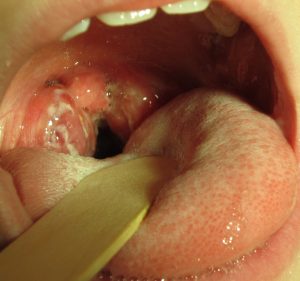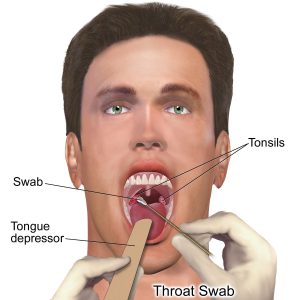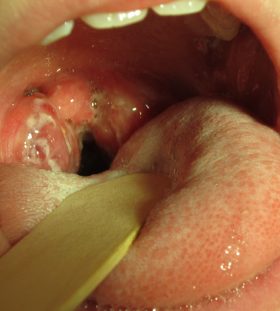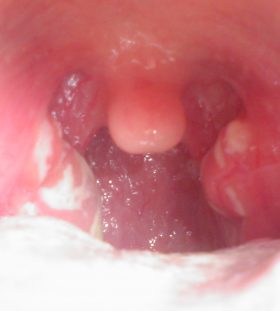Strep Throat Symptoms, Causes and How to Treat

If your child complains of a scratchy and sore throat, there is a possibility, though small, of him/her showing one of the key strep throat symptoms. Strep throat is also called streptococcal sore throat or streptococcal pharyngitis.
An exceedingly contagious infection that affects the throat and tonsils, strep throat is caused by Astreptococuus. This is a group of bacteria that you might otherwise recognize by the name Streptococcus pyogenes. The bacteria reside in the nose and throat.
Strep throat most commonly affects children, typically those in the age group of five to 15. Children are easy targets for strep throat symptoms and complications owing to their immune system is less familiar with germs. Children’s bodies have not been able to build up immunity to many bacteria and viruses that an older person would have been exposed to. At the same time, it is rare for a child below the age of 3 years to contract the illness.
Adults can also get the infection. They are at a greater risk of it if they are in frequent contact with children. The risk is also more if they have children of school age.
How does a strep throat effect?
Strep throat is responsible for only a small percentage of sore throats. In most other cases, the possible strep throat causes include irritants in the air, colds or other viruses. Frequently, a viral sore throat is accompanied by a running nose which is one way to distinguish it from strep throat. Other symptoms that suggest virus involvement are conjunctivitis (pink eye), no cough, and hoarseness (a breathy, strained or raspy sounding voice).
Viral sore throats usually resolve on their own with a low probability of complications. Strep throat, if left untreated, may lead to severe complications, though it is uncommon. Though usually a mild infection, strep throat can be quite painful. What’s more, if you got the infection once, there is no guarantee that you won’t get it again.

Strep Throat Symptoms
Here are some signs and symptoms to watch out for which could be indicative of strep throat. However, doing a diagnostic test is the best way to confirm the presence of bacterial infection. It will also help to rule out other causes. The symptoms may be mild in one person while severe in another.
- Sudden onset of throat pain
- Swollen and inflamed tonsils
- White patches in the area of the throat
- Headache
- Body aches
- A temperature of 101 degrees Fahrenheit or higher
- Rashes (scarlet fever)
- Swollen and inflamed tonsils
- Minute red spots situated on the rear of mouth roof
- Swallowing is painful
- Tender and inflamed lymph nodes and glands
- Vomiting
- Nausea
Strep throat symptoms usually begin within five days of coming into contact with the strep bacteria.
Causes of Strep Throat
At the outset, you read that this infection is caused by the Streptococcus pyogenes bacteria (group A Streptococcus). Close contact is key among the strep throat causes. Thus, sneezing, coughing, hugs, handshakes, the sharing of eatables and drinks and hugs are easy media for the contagious bacteria to pass from one person to another. When an infected person sneezes or coughs, they discharge bacteria-containing droplets into the air that aid in spreading the infection.
Near person to person contact is all the easier in places where large groups meet and assemble. This could be a day-care center, school, military training facility, university hostels, and more. If someone in a household has strep throat, it is common for the infection to spread to the other members.
Touching a bacteria-infected surface or item such as a towel, faucet, handle or doorknob, could cause infection too. This would happen if you touched your eyes, nose or mouth after touching the surface. Similarly, if you touch skin sores induced by group A Streptococcus, you could get sick with strep throat.
Experts are of the view that pets are not carriers of the strep throat bacteria. Being aware of strep throat symptoms is one way to keep yourself safe from a person who could possibly be a carrier of the infection. However, there are some people who carry the strep bacteria but do not display symptoms.

Strep Throat Diagnosis
It is not possible to make a strep throat diagnosis merely by looking into a person’s throat. However, it is important to identify strep throat at the earliest so that treatment can be started immediately. To identify whether group A strep is the cause of a sore throat, it is necessary to do a test.
Rapid Antigen Detection Test (RADT)
For this test, the doctor will first gently press your child’s tongue down using a depressor. After this, she will brush a cotton swab against the back area of the throat to get a sample. The results will be available quickly; it will take not more than 20 minutes. Should the results be negative but the doctor still suspects strep, she would likely carry out a throat culture test.
Throat Culture
Though the RADT provides quick results, it is not as precisely reliable as a throat culture. This test is able to detect infections that a rapid strep test may not pick up. In this test, the doctor will once again take a swab. She will brush it over the back of the throat and the tonsils to collect a bacteria sample.
The patient may have a tickling sensation while the procedure is being performed but it is not painful. The swab is given to a lab with the results being available within a day or two. The lab confirms or rules out strep throat by bacteriological culture or from finding streptococcal bacteria in the test sample.

Risk factors
One risk factor – age, has already been mentioned. Another risk factor would be the season. A strep throat infection may happen at any time of the year. However, the risk of contracting strep throat symptoms is higher in late fall and spring beginning. A person with a weakened immune system has a higher risk of coming down with the infection. The weakening could be from an immune system problem, organ transplant, cancer, HIV, AIDS or cancer.
Strep Throat Treatment and Types of Antibiotics
Antibiotic treatment is necessary for strep throat, to prevent serious complications. Once you start the course for your child or yourself, you must complete it. Though you may feel tempted to stop when you get better, don’t. Doing so could produce a relapse owing to some residual live bacterial.
In addition to averting dangerous complications and helping the patient recover, antibiotics also prevent the spread of strep throat infection. The strep throat antibiotics commonly prescribed are amoxicillin and phenoxymethylpenicillin. Alternatively, a prescription for azithromycin is possible if the patient is allergic to amoxicillin or penicillin.
To reduce fever and alleviate throat pain, acetaminophen or ibuprofen may help. These pain and fever relievers are available over-the-counter. Never give aspirin to children below the age of 16. Doing so could cause Reye’s syndrome, an uncommon but dangerous condition.
A patient with strep throat can get back to daycare, school or work if she has taken antibiotics for a minimum of 24 hours. In addition, she should not have a fever anymore.

Home Strep Throat Remedies and Lifestyle Changes
Here are some home treatments and tips to ease strep throat symptoms:
- Doing a warm saltwater gargle a few times every day will help to alleviate pain. Take a quarter teaspoon of salt and blend it with 8 ounces of warm water.
- Limit or avoid smoking altogether and try to keep away from second-hand smoke.
- Suck on an ice pop or drink broth, tea or other warm liquids. Sucking on hard sweets or lozenges also helps but refrain from giving young children hard or small items to suck on. This is to prevent choking.
- Hydrating the air using a humidifier can reduce pain and discomfort. This is by moistening the mucous membranes in the throat and nose.
- Ensure adequate rest and sleep.
- It is best to skip orange juice or such other highly acidic drinks because they sting. Also, avoid spicy foods.
- Soft foods such as soups, mashed potatoes, cooked cereals, yogurt, and applesauce are soothing to a sore throat. Pureeing in a blender helps make foods easier to swallow.
Complications
There are two key ways by which untreated strep leads to serious complications – from spreading of infection or because of impaired functioning of the immune system. Complications include:
Passing on of infection
- Sinusitis (sinus infection)
- Otitis media – infection of the middle ear which may even affect hearing
- Mastoiditis – infection of a portion of the skull at the back of the jaw (mastoid)
Peritonsular abscess
A collection of pus (abscess) that develops around the tonsils
Rheumatic fever
Non-treatment or inadequate treatment of strep throat amounts to there being some residual bacteria in the tonsils. This can cause a persistent immune reaction all through the body termed rheumatic fever. Inflammation develops in various areas of the body as the body starts attacking itself. The at-risk body parts and organs are the joints, brain, skin, and heart. Possible symptoms include jerky and rapid movements, cardiac inflammation, joint pain, hard nodules beneath the skin and fever. The inflammation of the heart is a very serious condition that may scar the heart valves and thereby call for heart valve replacement surgery.
Pediatric Autoimmune Neuropsychiatric Disorder (PANDAS)
There is an inference of a link between strep throat and the onset or worsening of Tourette’s syndrome and OCD (Obsessive Compulsive Disorder). This is PANDAS. Symptoms include tics, OCD, hyperactivity, fidgeting as associated with ADHD (attention deficit hyperactivity disorder), changes in motor skills, mood changes, handwriting alterations, bed wetting, emotional liability, and joint pain. PANDAS is treatable with antibiotics.
Post-streptococcal glomerulonephritis
This condition is an inflammation of the kidneys following a strep infection. Children below the age of seven years have the highest risk of getting this infection. Symptoms include fatigue, elevated blood pressure, reduced urine output, and frequency, dark reddish-brown coloration of urine, and swelling (face, hands, feet).
Fortunately, the glomerulonephritis usually resolves by itself without wreaking long-term damage to the kidneys.
Guttate psoriasis
A condition that results in teardrop shaped and red but small spots showing up on the body.
Swollen lymph nodes
This is a strep throat complication in the neck.
Prevention
There are three key things to keep in mind to prevent strep throat infection or its spread:
- Hand Hygiene – Wash your hands and your child’s hands frequently, particularly when in a crowded place and during strep season. It is good to always carry along an alcohol-based hand sanitizer in case soap is not available where you are.
- Avoid sharing items – If you notice that someone is sick, refrain from sharing food and drink, towels and utensils with her.
- Cover when you sneeze or cough – To prevent an existing infection from spreading, cough into a sleeve or sneeze into a tissue. Train your children to do the same. Hygienically dispose of used tissues.
Another thing you can do is boost your immune system and that of your children. Think along the lines of a well-balanced diet and regular exercise.
When to see a doctor
The following symptoms or situations call for immediate medical intervention
- A fever exceeding 104 degrees Fahrenheit in an adult or child
- A fever exceeding 100.4 degrees Fahrenheit in an infant 3 months old or younger
- Fever in a child aged 2 and above that lasts longer than 72 hours.
- Diagnosed strep throat that shows no improvement within 48 hours of antibiotic treatment
- Breathing trouble – if serious, call 911
Other situations requiring a doctor visit are a sudden rash, swallowing difficulty or a sore throat that persists for more than 48 hours.
To conclude, once strep throat symptoms are identified, immediate treatment with antibiotics will aid in a smooth recovery. Surgical extraction of the tonsils may be required in people with recurrent strep throat.




 Tagged:
strep throat antibiotics, strep throat remedies, strep throat treatment
Tagged:
strep throat antibiotics, strep throat remedies, strep throat treatment











